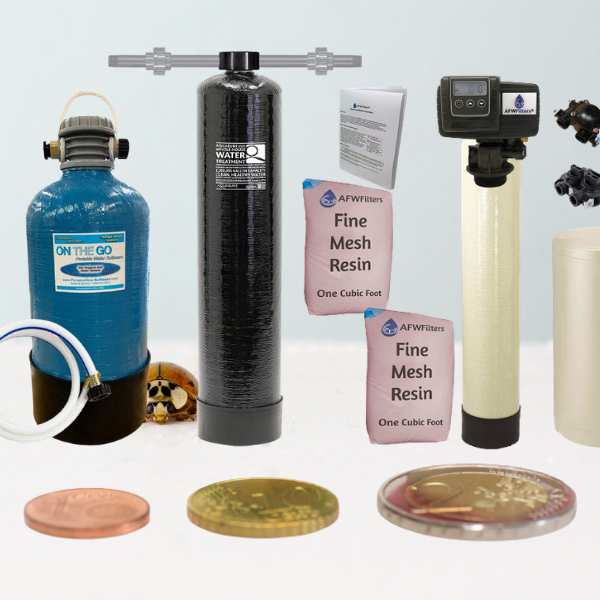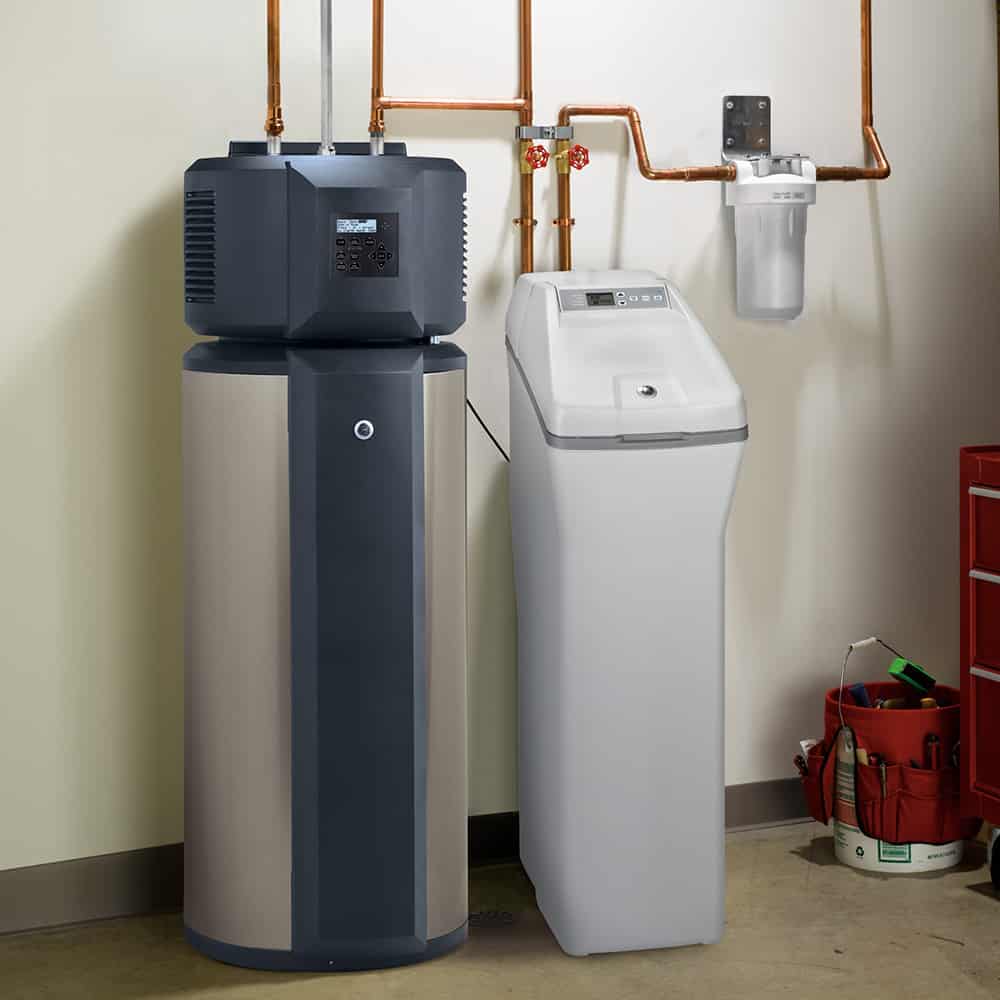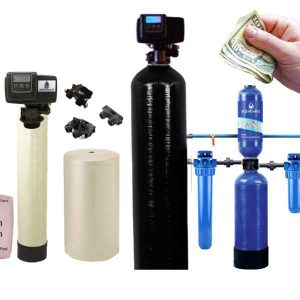How To Properly Size Your Water Softener?
To begin with, choosing a water softener alone can seem like a difficult task, but there are a few places where you can get the correct sizing information for a water softener.
Thinking about what size water softener do I need? The correct water softener size depends on a few pieces of information you certainly need to be aware of given below!

1) Water Hardness
The level of hard water running through your house depends on the area you live in. Chances are if like the majority, you’re getting a municipal or a well water supply, your water is most likely hard.
This means your water content consists of a high concentration of magnesium ions or calcium ions. These hard minerals increase the total hardness value of the water.
You can’t just guess your water hardness levels; instead, you need to be aware of the exact levels because these factors affect the water softener size. If you live in an area with a higher water softener concentration, it means you need a higher water softener capacity.
You can test water hardness through laboratory or DIY test kits. These tests are interpreted on the content of calcium carbonate in hard water. Levels are measured in parts per million(ppm) or grains per gallon(gpg).
- Soft water reads between 0-60 ppm and 0-3.5 gpg.
- Moderately hard water reads between 61-120 ppm and 3.56-7.01 gpg.
- Hard water reads at 121-180 ppm and 7.06-10.51 gpg
- Very hard water is anything greater than 181 ppm and 10.51 gpg.
Hardness level is crucial to determine. If you live in an extremely hard water area, you need a water softener with a larger resin bed to quickly ensure your house gets soft water.
Additionally, resin beds also require time for regeneration. Keeping this in mind, you should look for a water softener with maximum grain capacity. This will ensure a long time before the softener requires regeneration.
However, if you have slightly hard water, a smaller water softener with a lower grain capacity will work out perfectly fine!
2) Water Consumption
Your water usage is one definitive factor in knowing what size a water softener should be. To get an idea of your water usage, you can look at your water bill to estimate water usage in a certain period.
Once you have an estimate of your water consumption, you can deduce the grain capacity required. If you have water-based appliances and heavy water consumption, you’ll need a large water softener.
If, for whatever reason, you need to calculate your water consumption to know the proper grain capacity required, here’s how you can do so!
If the number of people at your house is 4, you can multiply that number by 80 or 100. If you’re big on conserving water, multiply the number of people by 80.
But if you have a higher per day water intake, multiply that number by 100. An overall estimate shows that a person can use between 80-100 gallons per day.
For example, with a higher water usage considering your appliances, a house of 4 people using 100 gallons a day can be calculated as 4 x 100= 400 gallons per day.
If you have an overall estimation of gallons used in a certain period, you can calculate it as follows:
Calculating 40,000 gallons in 100 days would be 400 gallons per day (40,000/100).
3) Calculating Water Softeners Grain Capacity
You need to figure out how much your grain capacity is. To work efficiently, your water softener needs to regenerate.
The resin bed needs to regenerate every week, so you should get a softener that lasts you through a week based on water hardness.
To know this, you’ll need an estimate of how many grains you need in a softener. That’ll help you understand how many hardness grains your water softener requires to function daily.
Use a testing kit to find out the hardness level of water in your area. For instance, if your result ends up as 10 grains per gallons, then you just need to multiply that with the gallons of water used per day:
10 grains per gallon x 400 gallons per day= 4000 grains hardness grains per day. So your water softener’s grain capacity for a day should be 4000 grains per day! Further, multiply that by 7, and you get the grains per week, which is 28,000 grains!
Water softeners are available as 24,000 grains, 32,000 grains, 48,000 grains, and 64,000 grains. The chart below will help you classify what size softener you should get according to your house needs!
| Number of People | ||||
| Hardness grains per gallon | 1-2 people | 3-4 people | 5-6 people | 7-8 people |
| 5-10 GPG | 32,000 Grain | 40,000 Grain | ||
| 11-20 GPG | 32,000 Grain | 40,000 Grain | 48,000 Grain | |
| 21-30 GPG | 32,000 Grain | 40,000 Grain | 64,000 Grain | 80,000 Grain |
| 31-40 GPG | 40,000 Grain | 64,000 Grain | 96,000 Grain | |
| 41-50 GPG | 64,000 Grain | 80,000 Grain | 96,000 Grain | 110,000 Grain |
| 51-75 GPG | 64,000 Grain | 80,000 Grain | 96,000 Grain | 110,000 Grain |
| 75-100 GPG | 80,000 Grain | 96,000 Grain | 110,000 Grain |
4) Considering The Flow Rate
A softener is no good if it’s unable to reach you consistently with a soft water supply. If your softener’s unable to provide you soft water during peak consumption, that suggests problems in flow rate!
Problems in flow rate will be apparent when hard water starts leaking through or if there’s a drop in water pressure. This is more likely to happen when almost all household members are running faucets or showers.
In this case, keep an eye out for a balanced flow rate. Generally, a familial household should have a minimum flow rate of 12 gallons per minute and a single household should have a flow rate between 6-7 gallons per minute.
As for usage, larger homes and houses require a larger flow rate!

Problems with an Undersized Water Softener
Getting your money’s worth is important. Getting an undersized water softener will take a toll on the total softening capacity if used beyond a certain level.
If you have a high water hardness concentration, a small-sized softener won’t work properly, especially with high usage. This brings you back to square one and invalidates the whole point.
Getting a smaller water softener will require more frequent regeneration cycles that make the softener work in the first place. In proper water softeners, these cycles occur on demand. So the higher the usage, the quicker the capacity of the grain will run out.
Another disadvantage to this is that frequent regeneration lessens the lifespan of your water softener as a whole since it affects the resin beads. So it’s pertinent you make sure you’re getting the properly sized water softener.
In either case, you want to make sure you’re going for the right size water softener since they aren’t a cheap deal!
Problems with an Oversized Water Softener
Buying an oversized softener has mostly one con; the money! An oversized water softener won’t help you if you’re trying to save money.
Compared to an undersized softener, an oversized softener will not require frequent regeneration cycles. Due to its size, it’ll be able to soften a larger quantity of water without hindrances in the flow rate.
Larger water softeners do cost more money but they are beneficial if you live in a family household with a high water consumption rate per day.
Compared to the undersized one, an oversized unit will help maximize salt efficiency. Greater salt efficiency means you won’t run low on salt levels. Due to this, regeneration cycles will run smoothly at an optimum grain capacity.
This does of course, mean they’ll be a higher water and salt use but it blends with the fact that the cycles decrease.
Although, even while buying an oversized water softener, you need to be aware of the system’s provided capacity to see how much and how frequently you’ll spend on salt!
Conclusion
Although both sizes get the job done, you’ll need to familiarise yourself with everything we’ve provided above to have your water system running smoothly!
We hope you get the right-sized water softener that’s worth your money!
